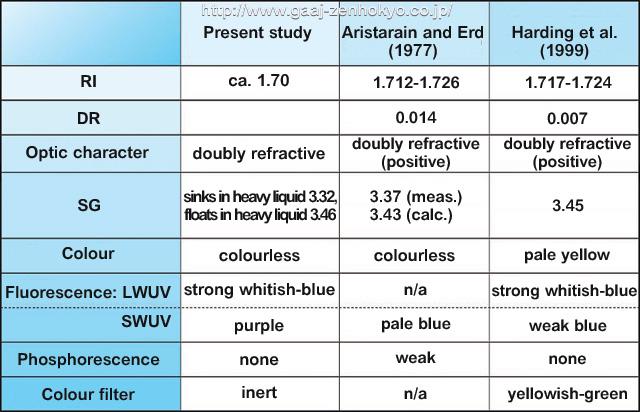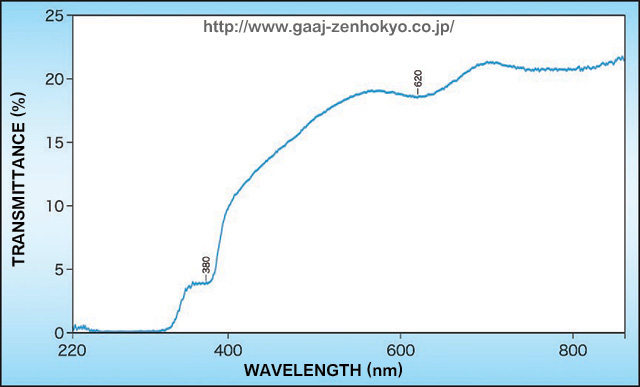|
||||||||||||||||
|
After inspection of a colourless transparent rough stone shown on the photo 1, it was proved to be a Johachidolite: CaAlB3O7. This is assumed to be the first time for Johachidolite, which is a very rare borate mineral, being submitted to a gemmological laboratory in Japan, and it gave us a good opportunity to introduce this rare stone here.
Historical background Johachidolite (or called Johachido-seki in Japanese), named after Johachido-district in North Korea where produces the material, was first reported by two Japanese, IWASE and SAITO, in 1942. They first thought a chemical composition of the mineral very complex as H6Na2Ca3Al4F5B6O20, but later in 1972 Moore and Araki deciphered in their report that Na and F were derived from impurities such as inclusions and they stated that the chemical composition of Johachidolite itself was CaAlB3O7. Further detailed analysis was made by Aristarain and Erd and this lead Johachidolite being confirmed as a new mineral having composition of CaAlB3O7 by IMA (International Mineralogical Association) in 1977. The first report on Johachidolite as a gemstone was made as "Johachidolite - a new gem" on Journal of Gemmology in 1999 by Harding with other authors. They reported on the first Johachidolite in amazingly big size submitted to GAGTL in London in the spring of 1998. Before that Johachidolite had been known as a colourless transparent to whitish colour rough stone in the size under 1mm, and Johachido-area in North Korea was the only locality reported, but this stone tested at GAGTL was a pale yellow transparent faceted stone weighing 14.02 ct. It was handled in Myanmar as a natural stone, but Harding and his co-authors made discussion in taking into consideration the possibility of synthetic origin because its yield is sporadic. They found no evidence of any sources of synthetic CaAl borates in current literature and concluded that the faceted stone they tested was natural. They also indicated that this Johachidolite weighing 14.02 ct might be from Mogok area in Myanmar, in consideration of occurrence condition of gem minerals that similarly contain boron such as shinhalite: MgAlBO4, danburite: CaB2(SiO4)2 or boron-containing tourmaline. Features of Johachidolite The Johachidolite we tested this time was a rough crystal weighing 3.330 ct and colourless transparent (with partly brownish yellow colour). Since its first report, Johachidolite has been said to show fluorescence characteristically under UV light, and the stone we tested also showed strong whitish-blue fluorescence under LWUV and purple fluorescence under SWUV. RI of the stone tested was about 1.70. According to former reference articles, the rough stone from Johachido-district measured by Aristarian and Erd (1977) had RI 1.712-1.726 with birefringence 0.014, and the faceted stone measured by Harding et al. (1999) had RI 1.717-1.724 with birefringence 0.007. Taking a difficulty of accurate measurement on this stone because of its rough condition into consideration, the RI value we obtained can be assumed almost the same with the RI values mentioned above. However, birefringence could not be measured in our test and it is unknown that which one of two birefringence data above, which show slight difference, is consistent. Also, the rough stone from Johachido-district tested by Aristarian and Erd (1977) was reportedly showing weak phosphorescence, while the faceted stone tested by Harding et al. (1999) reportedly showed no phosphorescence, likewise, the rough stone tested this time did not show phosphorescence. Furthermore Harding's report said the stone showed yellowish-green colour through a colour filter, but our rough stone was inert. The results of our tests and those of reference articles are compared in the table 1.
Identification of the stone by standard gemmological tests above was not sufficient and further detailed analyses by Raman spectral analysis, UV-Vis-NIR spectral analysis, fluorescent X-ray chemical analysis (ED-XRF) and LA-ICP-MS were performed to confirm the identity of Johachidolite. After measuring Raman scattering using 514 nm argon ion laser excitation, characteristic Raman spectrum showing peaks at 833, 668, 588, 478, 375, 347 and 285 cm-1 was obtained (figure 1). Among those, the peaks at 668 and 588 cm-1 were the most intense and others were rather weak. This result is consistent with that of Harding and co-authors, and thus we can determine the identification within non-destructive test range.
In further measurement of absorption spectrum by UV-visible spectrophotometer, shorter wavelength than 350 nm, which was an absorption end, were absorbed as well as broad absorptions around 620 and 380 nm were recognised in the wavelength range 860〜220 nm (figure 2). In NIR region, no characteristic absorption peak was confirmed in the range 800〜2500 nm. A spectrum measurement in infrared region by FTIR revealed that wavelengths lower than 2500 cm-1 were totally absorbed. In the wavelength region above 2500 cm-1, transmittance increased towards higher wavelength in the spectrum with a broad absorption around 3400 cm-1.
In ED-XRF analysis, which cannot detect boron, only calcium (Ca) and aluminium (Al) were detected as major elements. Silica (Si) and iron (Fe) were also detected as trace elements. For further detailed chemical compositional analysis, with the stone owner's consent, a component analysis was made by LA-ICP-MS and boron B (B2O3: 46.85 wt %), which had not been detected by ED-XRF analysis, was detected as one of major elements together with calcium Ca (CaO: 27.22 wt %) and aluminium Al (Al2O3: 25.09 wt %). These three elements occupy over 99 % of the stone component and this result matches to the composition of Johachidolite, CaAlB3O7. Other than these three, twenty-eight elements were detected as trace elements. They are, from the higher content; Si (2000-4000 ppm), Tl (190-1450 ppm), Th (30-1590 ppm), Mg (310-500 ppm), Fe (210-240 ppm), K (3-310 ppm), Be (60-230 ppm), Sr (110-120 ppm), Na (76-120 ppm), Ce (58-150 ppm), La (50-150 ppm), Ga (83-87 ppm), U (0.8-61 ppm), Nd (10-42 ppm), P (14-28 ppm), and Ti (2-20 ppm); V, Zn, Y, Pr, Sm, Gd, Dy and Pb are up to 15 ppm; Mn, Zr, Eu and Bi are under 1 ppm. Component elements were significantly different between colourless part and yellow part of the crystal, and the colourless area showed high contents of Mg, Si, K, Ti, La, Ce, Pr, Nd, Sm, Ti, Th and U; while the yellow part contains more Be and Fe. To author's knowledge, a report confirming detail quantitative composition of Johachidolite has not been made so far and our study is the first one. To date, circulation of Johachidolite on the market in Japan is scarce and this stone is a very rare gem. According to our client who submitted the stone, the rough we tested is from Mogok area in Myanmar, and there may be a possibility of Johachidolite from Mogok will flow into the gem market in near future. So, it is a noteworthy material as a rare gemstone hereafter. |



